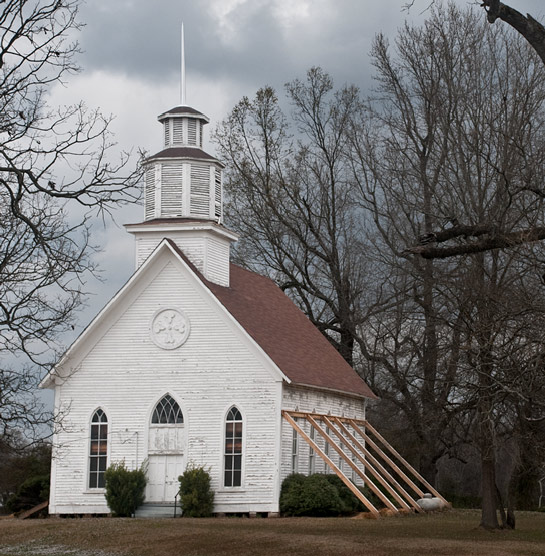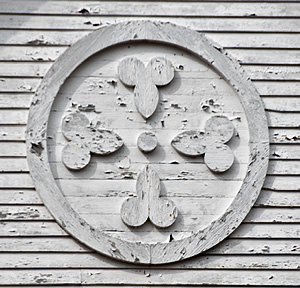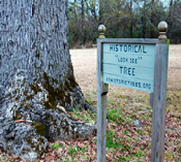|
|
|
|
 |
|
|
|


Sunday, March 21, 2010 Plumb what? Think adjective — plumb, as in level, straight, not crooked nor leaning. This is a recent condition for the structure pictured above. In the spring of 2008, an ill westerly wind buffeted Selma, Arkansas, and seemed to concentrate its fury on the 136-year-old Selma Methodist Church. When the winds subsided, there was a decided easterly list to the sanctuary. On the inside the news got worse. The west wall had separated from the floor. Over the next few weeks, gravity — having no respect for houses of worship — exacerbated the gap. If something wasn’t done, the old church would unceremoniously bite the Arkansas dust. Turns out, Brian Driscoll of the Arkansas Historical Preservation Society took a special interest in the church and its rapidly deteriorating condition, according to Dorris Watson of Selma, who leads the charge for the church’s restoration group, the Selma Methodist Church Preservation Society. As a result of Brian’s interest, the group was organized, learned of grant sources to address the church’s pressing issues, and sprang dutifully into action. (The church was placed on the National Register of Historic Places in 1972.)  Selma Methodist Church, March 7, 2009. Like the Cathedral of Notre Dame, Selma Methodist Church had its very own flying buttresses. Local donations, bolstered by grants from the Methodist Church and the Arkansas Historical Preservation program, provided funds to stabilize the church until more detailed plans were made and more funds were raised. Architect Gary Clements of Clements and Associates visited the site, took the project under the professional wings of his firm, and conjured up the successful stabilization strategy. As you can see from the March 7 photo, the church building was practically sitting on the ground. In a few places it stood barely six inches from mother earth. Over the years the building had settled, necessitating a complete restructuring of the foundation. There was only one problem. The church was in the way of the foundation. The obvious answer was to move the church. In this case, straight up.
The Selma Methodist Church Preservation Society is now in the process of raising the next round of funds, which will be used to leverage additional grants. Plans are to restore the church to 1874 style, with, of course, a few instances of deference to contemporary conveniences. Speaking of which, I do have one suggestion. Please run the power lines underground so that, as future generations of photographers record the pristine restoration, the comment “$#@*$%!@!** wires” will not be heard (again) on this hallowed ground. 
Most of the time, there is more to the Photo of the Week story than can be told in an essay. And most of the time there are more pictures to be seen. Presuming that some folk will enjoy being privy to this trove of information, I have created a blog, “Weekly Grist for the Eyes and Mind,” where I am showing and telling “the rest of the story." There are also some blatantly commercial mentions of some of the things we do to earn our beans and taters. Click on the Weekly Grist logo and go to the blog. — J. D.
 |
|
|
|
|
|

|
|
|
|
CornDancer.com is the personal website of Dr. Freddie A. Bowles and Ebenezer Baldwin Bowles.
CornDancer has participated in the World Wide Web since 2000. Submissions are invited. Contact webmaster at threadspinner@corndancer.com |
|
|
|




